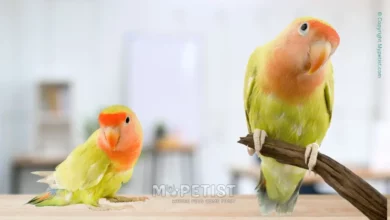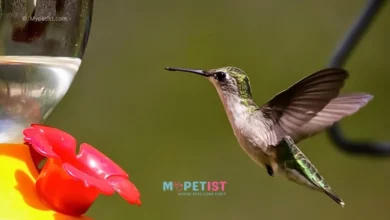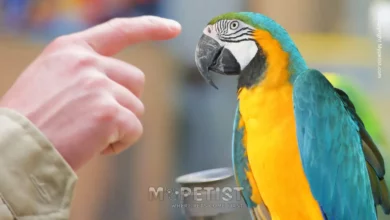10 Common Parrot Body Language Signals and What They Mean
Parrots are wonderful and intelligent feathered creatures that make for great pets. They can learn to speak, and even perform tricks – but did you know that parrots also communicate through body language? Understanding how your parrot communicates with you can help strengthen your bond as well as keep them healthy and happy. In this article, we’ll explore 10 common parrot body language signals and what they mean.
Table of Contents
parrot body language
Parrots are fascinating animals with a unique body language. Their expressive features allow them to communicate through various movements, postures, and vocalizations. Understanding parrot body language is crucial for their overall health and well-being because it helps identify their emotional state and trigger response accordingly. Reading their body language is important for parrot owners as it allows them to understand their pet’s mood, comfort level, and communication needs. Some common body language cues of parrots include fluffing of feathers, eye pinning, bobbing of the head, and vocalizations. By studying these cues, one can easily detect when their parrot is happy, agitated, or stressed. In conclusion, learning about parrot body language adds an extra dimension to the human-parrot relationship and helps to ensure that both parties communicate effectively.
why understanding parrot body language is important for bird owners
Understanding parrot body language is crucial for bird owners because it enables them to understand their pets more effectively. Parrots use a range of signals and gestures to convey mood, emotion, and intentions, and an experienced owner will be able to read these cues and respond appropriately. For example, a parrot that is puffing up its feathers may be indicating aggression or fear, while a bird that is leaning forward and chirping excitedly may be feeling playful.
By learning to recognize these signals, owners can ensure they provide the right type of interaction and care for their feathered friends. This can help to build trust and strengthen the bond between owner and bird, making for a happier and healthier pet overall. Moreover, understanding parrot body language can enable owners to detect potential health issues or problems before they become serious, allowing for prompt treatment and care.
Head movements
how head movements (nodding, shaking, bobbing) can indicate a parrot’s mood
Head movements can be a telltale sign of a parrot’s mood, and experienced bird handlers can read them well. For instance, nodding usually means the bird is happy, and they might do it to show off to their owner or indicate they are eager to play. Shaking, on the other hand, is generally a warning sign of aggression or a pet being upset, and it could indicate that the parrot is feeling threatened.
Bobbing is often associated with curiosity, with the bird trying to get a closer look at something that interests them. However, constant bobbing might indicate a level of anxiety or nervousness. It is essential to pay attention to a parrot’s head movements and body language in general, as they communicate through their actions much more than through their vocalizations.
Explain what different head movements may mean
Parrots are known for their expressive nature, and one of the ways they convey their emotions is through head movements. Different head movements of parrots indicate various things. For instance, a parrot bowing its head in a submissive position is a sign of respect and submission. On the other hand, if a parrot is leaning its head forward and blinking its eyes, it means it is interested or curious about something.
A parrot who tosses its head back and forth could be anxious or frustrated. When a parrot bobs its head up and down, it means it is happy and enthusiastic. Additionally, a parrot jerking its head towards its shoulders may signify illness or discomfort. Researchers have found that the head movements of parrots are unique to different species and may vary depending on individual temperament and moods. Understanding these head movements can help parrot owners communicate better with their pets and ensure their overall well-being.
Beak movements
Discuss how beak movements (grinding, clacking, beak wiping) can reveal a parrot’s emotions
Beak movements are incredibly important for understanding a parrot’s emotions. Grinding is a common sign of contentment and relaxation, and is often heard when a parrot is resting or being petted. Clacking, on the other hand, is a more intense movement that is usually associated with aggression or excitement.
If a parrot is feeling threatened or territorial, they may begin clacking their beak as a warning to others to stay away. Wiping the beak is yet another behavior to pay attention to. It can indicate that a parrot is feeling anxious or stressed, as they may be using this behavior to self-soothe or calm themselves down.
By paying attention to a parrot’s beak movements, we can better understand their emotional state and provide them with the care and attention they need.
Provide examples of what different beak movements may signify
Parrots use their beaks for communication, and different beak movements can signify different things. Some common examples include grinding or chattering of the beak, which can indicate contentment or excitement, whereas clenching the beak shut can indicate aggression or defensiveness. Flaring of the beak can show that the parrot is agitated or stressed, whereas pinching the beak can be a sign of pain or discomfort. Soft nibbling or grooming of feathers or skin can show affection, while forceful beak banging or grabbing can indicate a desire for attention or food. Overall, it is important to observe and understand the different beak movements of parrots to better understand their moods and needs.
Wing positioning
Explain how the position of a parrot’s wings can show whether it is agitated or relaxed A parrot’s wings can provide significant insight into its emotions. When a parrot is agitated or feeling threatened, it will likely spread its wings out wide and flare its feathers. This is a signal that it is ready for action or about to take flight. On the other hand, when a parrot is relaxed and content, it will likely hold its wings close to its body. The feathers may appear more sleek and streamlined in this position, indicating that the parrot is not feeling threatened or afraid. Additionally, when a parrot is feeling relaxed and happy, it may loosen its grip on its perch, allowing its wings to droop slightly. Observing a parrot’s body language and wing movements can be incredibly helpful for owners who want to ensure that their birds are comfortable and happy.
Outline examples of what different wing positions may indicate
The position of a bird’s wings can indicate several things. A bird with its wings fully extended suggests it is preparing to take flight, while a bird with its wings tucked against its sides might indicate resting, roosting, or trying to regulate body temperature. A bird with its wings raised above its back suggests it is agitated, while a bird with its wings partially spread may indicate it is about to take off or is trying to catch a breeze for balance. Additionally, a bird with only one wing extended might be injured or in pain, while a bird with its wings flapping vigorously may be attempting to intimidate a predator or display fitness during courtship. In summary, the position of a bird’s wings can provide valuable insight into its behavior and mood.
Feather fluffing
Describe how feather fluffing can signify a parrot’s emotional state
Feather fluffing is a common behavior seen in parrots and it can indicate their emotional state. When a parrot fluffs up its feathers, it can mean several things. If the feathers are just slightly fluffed, then it’s an indication of relaxation and contentment. However, if the bird is excessively fluffing its feathers, then it can be a sign of discomfort, fear, or anxiety. This behavior is similar to when humans shake or shiver when they’re upset or cold. Additionally, feather fluffing can also indicate an illness in a parrot. It is important for bird owners to pay attention to their parrot’s feather behavior as it is a crucial indicator of their emotional and physical state. By understanding their parrot’s communication cues, bird owners can ensure their pet’s well-being and provide appropriate care when needed.
examples of what different levels of feather fluffing may indicate
Feather fluffing is a common behavior seen in birds, which can indicate their emotional state and physical condition. A fluffed bird may indicate that it is cold or unwell, as they fluff their feathers to trap air and create insulation. However, the level of feather fluffing can also indicate different things. For example, a slightly fluffed bird may show that it is in a content and relaxed state, possibly ready to sleep or rest. On the other hand, a highly fluffed bird may indicate it is feeling stressed, anxious or even scared. This level of fluffing could occur when a bird is being introduced to a new environment or has seen a possible predator. In contrast, an aggressive bird may fluff up to appear larger and more intimidating to a potential threat. Therefore, observing the amount of feather fluffing can provide critical information to a bird’s wellbeing and emotional state.
Eye shape and size
Discuss how a parrot’s eye shape and size can indicate its mood The shape and size of a parrot’s eye can provide important clues about its mood. Generally, if the birds are in a relaxed state or content, their pupils will be fairly small and circular. However, if they are feeling threatened or frightened, their pupils will dilate and expand into a more rounded shape, allowing them to take in as much information as possible about their surroundings. Likewise, if a parrot is feeling aggressive or territorial, its pupils will constrict and become narrow, making it appear more focused and intense. Furthermore, the color of a parrot’s eyes can also indicate its mood. Bright, alert eyes are often a sign of a healthy and happy bird, while dull, sunken eyes may indicate that the bird is ill or under stress. Overall, understanding these subtle cues can help you better care for and communicate with your feathered friend.
Explain what different eye shapes and sizes may mean Parrots come in a variety of eye shapes and sizes, and this can indicate different things about their behavior and personalities. For example, parrots with large, round eyes tend to be more active and curious, while those with small, narrow eyes can be more cautious and reserved. Additionally, some parrots have eyes that are positioned more towards the front of their heads, giving them better depth perception and the ability to judge distances accurately. On the other hand, parrots with eyes that are positioned more towards the sides of their heads have wider fields of vision, allowing them to detect potential predators more easily. Overall, the size and shape of a parrot’s eyes can reveal useful insights into their natural instincts and behavior, which can be helpful for understanding and training these intelligent birds.
Pupil dilation
how a parrot’s pupil dilation can reveal its emotions
Parrots are known for their ability to mimic human speech, but they are also known for their exceptional ability to express emotions. One way to read a parrot’s emotions is through its pupil dilation. Just like humans, parrots’ pupils contract in bright light and expand in dim light. However, research has shown that pupil dilation can also indicate a parrot’s emotional state. When a parrot is feeling happy, engaged or aroused, its pupils tend to dilate, becoming larger and rounder. On the other hand, when a parrot is feeling afraid, nervous or defensive, its pupils tend to contract, becoming smaller and more oval-shaped. Understanding a parrot’s pupil dilation can help pet owners better understand their parrot’s emotional state, allowing them to respond in the most appropriate way possible.
examples of what different levels of pupil dilation may indicate
Pupil dilation is the process of the pupils in our eyes getting bigger or smaller in response to different stimuli. The size of the pupils can indicate different things about a person’s health and emotions. For example, during a fight or flight response, the pupils dilate to let in more light and improve vision, allowing the person to better detect potential threats. On the other hand, when a person is relaxed, their pupils will constrict to reduce the amount of light entering their eyes. Abnormal pupil dilation can also indicate serious medical conditions, such as head trauma or drug use. In some cases, one dilated pupil and one constricted pupil can indicate a brain injury or tumor. Therefore, monitoring the size of a person’s pupils can provide valuable information about their health and emotional state.
Tail positioning
Describe how the position of a parrot’s tail can indicate its mood
A parrot’s tail can be a good indication of its mood. A happy and content parrot will usually have its tail feathers relaxed and slightly spread out. However, if a parrot is scared or stressed, its tail feathers will be tightly held together and pointing downwards. If a parrot is angry or defensive, it may hold its tail feathers tightly together and slightly upwards, while puffing up its body to appear larger. Additionally, when a parrot is exploring or curious, it may hold its tail feathers partially fanned out, with slight movement. Understanding the different positions of a parrot’s tail can be helpful in determining its emotional state and how to approach it appropriately.
Outline examples of what different tail positions may signify
Tail position is an important communication tool for many animals, including dogs and cats. Different tail positions can indicate a range of emotions or behaviors. For example, a high and stiff tail might signal aggression, while a relaxed wagging tail could indicate friendliness. A tail tucked between the legs might signify fear or submission. Fluffy, puffed-up tails can mean a cat is scared or feeling threatened. Dogs might put their tails straight up in the air to show confidence or excitement, while a curved tail can indicate playfulness. A constantly twitching tail can mean confusion or uncertainty. It’s important to pay attention to the position of an animal’s tail and other body language cues to understand what they might be feeling or communicating.
Vocalizations
Explain how a parrot’s vocalizations can reveal its emotions
Parrots are known for their ability to mimic human words and phrases, but their vocalizations go beyond just repeating what they hear. A parrot’s vocalizations can reveal its emotions and state of mind. For instance, a happy parrot may make cheerful sounds like whistling, singing or even clicking its tongue. It may also make soft, contented sounds like purring or cooing. On the other hand, an unhappy or agitated parrot may make screeching or screaming sounds. It may also become quieter than usual or stop vocalizing altogether. In addition to their vocalizations, parrots also use body language to communicate their emotions. They may puff up their feathers when feeling threatened, or flap their wings when excited. By understanding a parrot’s vocalizations and body language, their owner can better understand what the parrot is feeling and respond appropriately.
examples of what different sounds or tones may mean
Sounds and tones can convey a wide range of meanings depending on the context in which they are used. For example, a high-pitched scream may indicate fear, pain, or excitement. A soft and soothing voice may indicate comfort, while a harsh and angry tone can indicate frustration or aggression. In music, minor chords are often associated with sadness or melancholy, while major chords convey a more uplifting or joyful tone. In speech, the way in which words are emphasized can completely change the meaning of a sentence. A higher pitch on the final word of a sentence can convey a question, while stressing a certain word can change the emphasis and meaning of the entire sentence. Overall, sounds and tones can communicate a vast array of emotions and ideas, making them an important aspect of effective communication.
Final Thoughts
Parrots are far more expressive than we can imagine! They use body language to communicate their feelings and desires, just like humans do. By understanding the most common parrot body language signals and knowing what they mean, you can better understand your parrot’s behavior. Knowing how to read your parrot’s body language will help you foster a better relationship with them, which is essential for any pet-owner.




